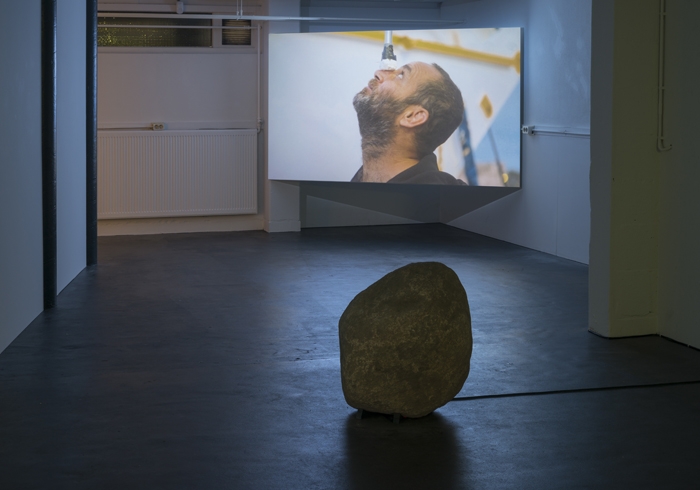With the Dutch capital’s galleries and museums getting together for the annual Amsterdam Art Weekend, Louise Darblay picks five highlight shows to see..
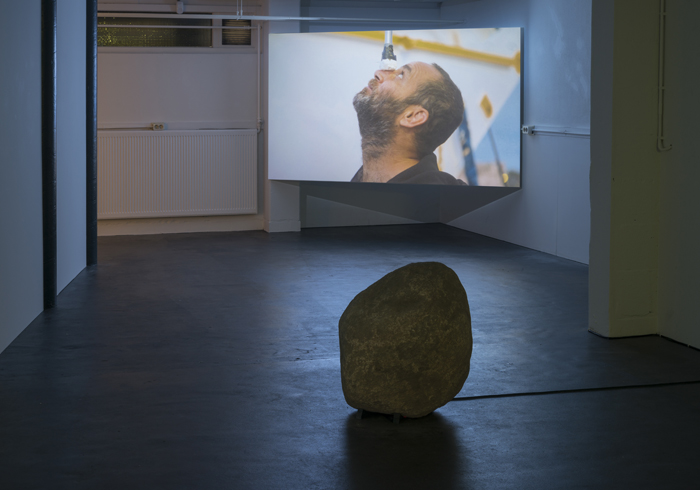
Hiwa K: To remember, sometimes you need different archeological tools, De Appel, through 16 December
The receptionist at De Appel is happy to see me; not many people venture outside the ‘ring’ she tells me, where the art centre is now located. Yet the Hiwa K exhibition will make it worth the trip: I’m not just saying that because the Berlin-based, Iraqi-Kurdish-born artist features on the cover of ArtReview’s November Power 100 issue as well as the pages of the magazine with two artists projects; but because his work tackles with great simplicity (and to even greater impact) some of today’s most pressing issues: migration, displacement, exile, civil struggles, identity and belonging… The way he achieves that is through narration; K is a great storyteller, and most the time, the point of departure for his videowork are stories collected from people he met, or his own experience, whether it’s the artist’s journey as a refugee, fleeing his home country by foot in the 1990s, in Pre-image (all works 2017); or the story of a fictional character named K, who’s had to memorise the map of a city (one considered to be an ‘unsafe zone’) to convince immigration officers to grant him political asylum, in A view from Above (both films made for Documenta 14). For this show, K created a new three-channel installation, Pin Down in which he’s shown wrestling with philosopher Bakir Ali (now a taxi driver in Berlin), as they discuss many of the themes present in his work – the wrestling becoming a metaphor for the inability to express or the frustration some of these subjects may cause.
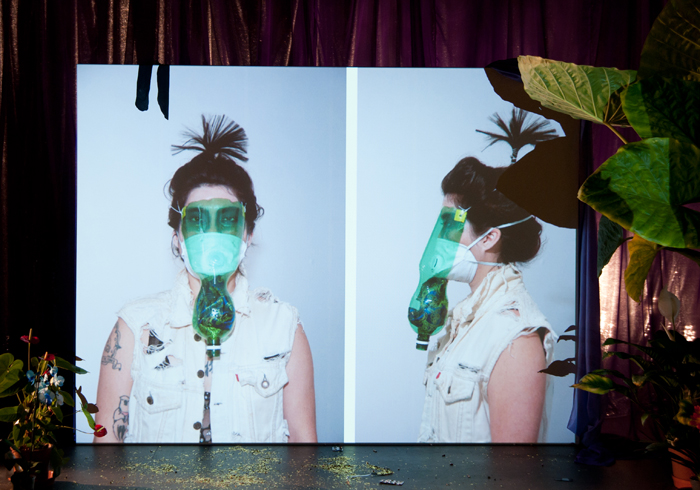
Terrestrial Records at Manifesta HQ, through 25 May
Organised by gallerist Ellen Bruijne in the opulent seventeenth-century merchant house that hosts the Manifesta biennial offices, Terrestrial Records gathers works by six artists on Bruijne’s gallery roster which reflect on our relationship with nature and society, and how toxic these can become. An installation of panels and delicate embroideries by Falke Pisano highlights the role of culture and society in shaping sciences, in particular mathematics, and considers different possibilities of measuring and understand the world; while works by Lara Almarcegui pursue the artist’s ongoing research into our natural and built environments, notably interrogating the notion of mineral ownership (by which private individuals or companies own not the surface of land but the ground underneath). The highlight here though is Toxic (2012) by Renate Lorenz and Pauline Boudry. Looking at a historical definition of queerness, the installation features a large glitter curtain as the backdrop to a display of mugshots of queer and transvestites arrested in the 1870s, collected from the Paris police archive, and a video featuring a drag queen and a punkish woman evolving in a ‘toxic’ environment. I’ve said too much already.
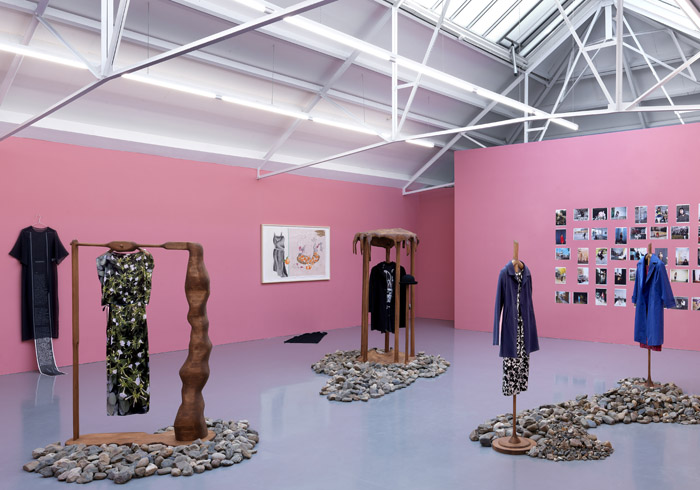
Evelyn Taocheng Wang: Four Season of Woman Tragedy at Galerie Fons Welters, through 6 January
Chinese-born, Amsterdam-based Evelyn Taocheng Wang (one of ArtReview Asia’s Future Great artists) gets her second solo show at Galerie Fons Welters. Combining various techniques on rice paper, Wang’s works often illustrate personal stories or fantasies through delicate, impressively precise drawings (Wang trained in classical Chinese painting) – in the series Massage near me (2015–), illustrating some of the awkward situations she experienced working as a (Asian) masseuse. This show retraces some of defining influences for the artist, including the collections of French fashion designer Agnès b., displayed on the floor of the gallery and on specially-designed wooden hangers, and Virginia Woolf’s tragic novel To The Lighthouse (1927), quotes from which are inscribed on the mixed-media paintings. Also featuring a series of photographs of the artist sporting some more designs by the French couturiere, this show is a personal and elegant interrogation of feminism, femininity and self-image.
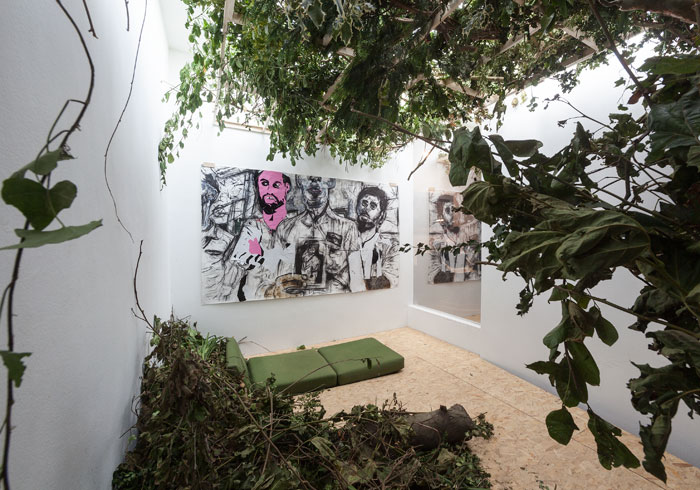
Erik van Lieshout: G.O.A.T. at Annet Gelink, through 23 December
“There’s nothing to see… it’s really uninteresting”, says van Lieshout in the video installation G.O.A.T., presented at Annet Gelink. Accessible through a sprawling wooden structure and dried foliage, the one-hour video was filmed at last year’s Kochi-Muziris Biennale where the artist was invited to present a work, but instead decided to inhabit the space he was allocated and build the work through his interaction with the audience – and two actual goats – for the duration of the biennial. In the resulting film we see the Dutch artist by turns perform, provoke, strike up conversations about politics or gender roles in Hindu society with visitors, but we also witness various visits by the authorities demanding the removal of collages and drawings by the artist (some of which mix images of Hindu goddesses with denuded pop icons). Bad-taste provocation or healthy stirring-up?
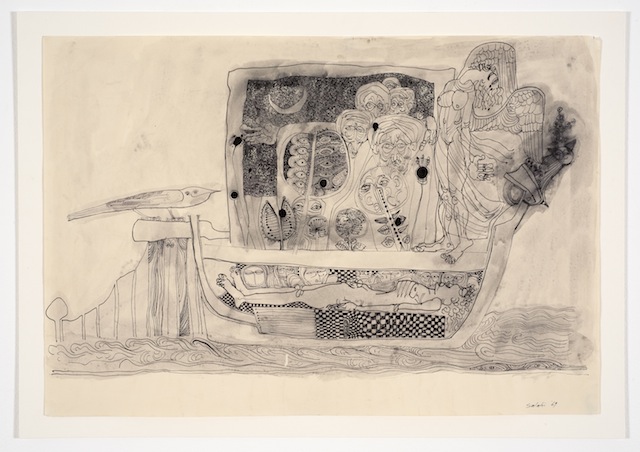
By His Will, We Teach Birds How to Fly: Ibrahim El-Salahi in Black and White at Prince Claus Fund Gallery, 23 November – 2 March
The revival of interest in the Sudanese modernist Ibrahim El-Salahi continues: though he studied at the Slade School of Art in London in the 1950s and has been living in the UK since the 1990s, the Sudanese artist only received his first UK show in 2013 at Tate Modern. He is now the subject of a survey show at the Prince Claus Fund (running concurrently with shows by David Hammons and Stanley Brouwn), which focuses on the artist’s works on paper. Mostly drawn in ballpoint pen, sometimes with ink and was, the drawings often depict with great detail and imagination dreamlike worlds and figures. Yet most of them stem from very real subjects, such as the six months he spent in prison in 1975 for alleged ‘anti-government’ activities, and which he documented in The Prison Notebooks (1976, rendered here digitally), or the Arab Spring series (2011). In an almost surrealist manner, the drawings seem to tap deep into the artist dreams and fantasies, while also carrying a sort of mystical charge. A recurring motif throughout is that of the bird, which appears in most of these ‘visions’ as a poetic allegorical representation of the artist and, more generally, of his passion for freedom.
